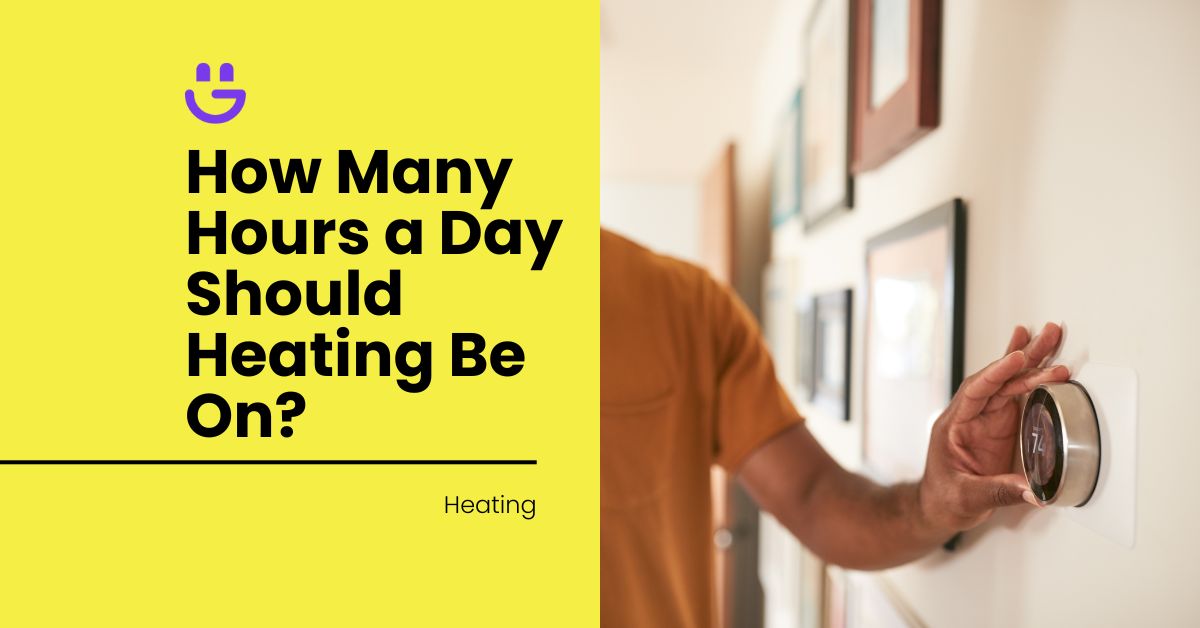Last Updated on November 14, 2025
Heating should be on for about 8 to 10 hours a day – but sometimes it’s not as simple as that. The increased cost of living has bogged down the UK in recent years, which makes figuring out how long to keep your heating system on so important.
Rising energy costs and managing your energy consumption is a delicate balance of energy savings and comfort.
If you want to relish in a cosy home 27/4 – especially in winter when we’re tempted to crank up the thermostat – then expect energy bills to skyrocket!
On the flip side, if you’re eco-conscious and want to reduce your carbon footprint and save money, you need to implement a few cost-effective heating strategies.
Luckily, all you need to do is read our article. It’s the ultimate energy-saving game plan. In 15 minutes you’ll have your answer. Simple.
We’ll cover everything from the recommended average temperature for your home to saving energy tips.
So what are you waiting for? Let’s put average heating times and tips to good use and start optimising your home heating system today!
Contents
Ideal Room Temperature And Health Implications
Achieving thermal bliss isn’t just about comfort; it’s about striking a balance between your well-being and energy efficiency.
We’re not saying you need to turn radiator valves down to zero, because let’s be honest, that’s not fun for anybody.
Managing the temperature in your home is a lot easier than you think. Both high and low temperatures are associated with health risks but introducing a few tweaks to your daily routine will make a world of difference!
What is the ideal room temperature?
Temperatures should be in the range of 18°C to 21°C, with 19°C being the optimum. Temperatures should neither be too hot nor too cold but “just right”. However, certain factors, like when there are vulnerable individuals (e.g. babies or the elderly) in your home, can impact this “average” temperature range.
Health risks
Those health risks we spoke about earlier, let’s touch on these quickly:
- Many studies have shown, temperatures below 18°C can negatively affect our physical and mental health.
- Homes where temperatures drop below 18.2°C have a nasty effect on vulnerable individuals who also suffer from chronic respiratory diseases and conditions, according to Public Health Wales.
- The Welsh government also recommends vulnerable households should set thermostats to 23°C in the living room and 18°C in other rooms for 16 hours a day.
- According to the National Institute of Medicine (NIM), too high temperatures also harm our health. This is determined by an individual’s ability to cool itself down, through perspiration (sweating).
- When our bodies get too hot, we may experience:
- Light-headedness
- Nausea
- Dehydration
- High blood pressure
- Difficulty breathing
- Fainting
- Headaches/migraines
- Lack of concentration
- Extreme fatigue
- Kids, the elderly, and those with psychiatric, cardiovascular and pulmonary illnesses are less equipped to handle the physiological response to heat.
In 2018, Dr Stephen Jivraj from University College London, Institute of Epidemiology & Health Care, said: “Our research has helped to explain the higher rates of hypertension, as well as potential increases in deaths from stroke and heart disease, in the winter months, suggesting indoor temperatures should be taken more seriously in diagnosis and treatment decisions”.
Additionally, the study found that for every 1°C indoor temperatures drop by, an increase of 0.48 mmHg in systolic blood pressure and 0.45 mmHg in diastolic blood pressure was found.
Top tip: Invest in a room thermometer to monitor your home’s temperature and ensure you’re staying within the ideal range.
Factors Influencing Heating Duration
Finding the sweet spot between an economical temperature, heating duration, and heating bills is determined by various things. Just as the weather changes, so should your heating schedule. There’s really no need for heating systems to run at full tint 24/7.
Let Eco Happy unravel a couple of the factors that impact your heating schedule:
Weather conditions
- Sunny days: On those glorious days, you might be able to ditch the heating altogether. Open windows and bask in the natural heat, using a light sweater if it gets a bit chilly. Remember, every degree you lower the thermostat can make a significant difference in energy consumption.
- Chilly days: As the temperature dips, your heating system will start to hum to life. Aim for targeted bursts in the morning and evening when you’re actively using the space. Think of it as warming up the stage for your daily activities. During the day, consider layering up or cuddling under a blanket instead of cranking up the thermostat.
- Freezing days: On those teeth-chattering days, your heating system might need to become a constant companion. However, even during arctic blasts, you can still be strategic. Focus on heating the main living areas where you spend the most time. Bedrooms can have slightly lower temperatures, especially if you’re tucked away under a warm duvet.
Lifestyle and occupancy
- Heating durations are based on the size of your home and how many people live in it. It’s also worth taking into account if you have any vulnerable individuals living with you, such as small children or elderly parents.
- Your and your family’s lifestyle routines and daily habits play a pivotal role in heating times. These factors determine your energy demand and how many hours a day your heating should be on.
Example: Let’s say you’re a parent of three teenage boys, and these boys love to play football. Most times they will shower twice a day (we hope!) not to mention all the grass-stained sports clothes you need to wash. If this sounds familiar, your household has a fairly large heating demand.
Alternatively, single-person households will have significantly lower heating demands in comparison.
Property characteristics
Insulation quality
Think of your home’s insulation as a cosy coat. A well-insulated house retains heat better than poorly insulated ones. This reduces the demand on your heating system and keeps heating bills to a minimum. On the other hand, home heating systems need to work twice as hard to generate the same amount of heat in low-insulated houses.
Consider wall, floor, and loft insulation to maximise the cosiness of your living space. This small yet effective tip can drastically lower heating bills.
Home size
As mentioned, house size plays a role in heating schedules. Think about a 5-bedroom house with six people living in it; as opposed to a single bachelor living in a 1-bed bungalow. See the difference? The contrast in how much energy is used in each scenario is vastly different.
Here’s an annual energy usage estimation:
- 1-bed house (1-2 people) = 7,500 kWh gas and 1,800 kWh electricity
- 2-bed house (2-3 people) = 11,500 kWh and 2,700 kWh electricity
- 4+ bed house (5+ people) = 17,000 gas and 4,100 kWh electricity
Boiler efficiency
Boilers are the heart of the home, pumping warmth and hot water through heating systems and radiators. Modern boilers have an “A” Energy Performance Certificate (EPC) rating and are roughly 90% energy efficient. This means they give us 90p of heat for every £1 spent.
However, old or faulty boilers have a lower energy efficiency rating, usually in the range of 75-80%. Not only do older boilers impact energy bills, but they also impact how many hours a day your heating should run for sufficient warmth.
Example: On average, modern boilers take about 40 – 60 minutes to heat up. Older models, with lower energy EPC ratings, typically take 90 – 135 minutes. That’s roughly 1.5 times longer, affecting your schedule and your wallet!
Fun fact: According to an Energy Saving Trust report, the average household produces 2,690 kg of carbon dioxide (CO2) from central heating and hot water each year. To reach the UK’s net zero goals, we need to reduce this to 140 kg per home!
Cost Of Running Central Heating
Here we’ll delve into the various costs of running heating systems at home.
Variables affecting costs
- Fuel type: The fuel type (gas, oil, or electricity) you use will significantly impact heating costs. Currently, gas is charged at 7,42 p per kWh and electricity at 28,62 p per kWh.
- Boiler efficiency: Modern boilers burn fuel more efficiently, meaning less energy wasted and lower bills.
- Insulation: Homes with poor insulation will have higher energy bills as systems need to work harder to maintain heat.
- Thermostatic radiator valves: Every degree counts! Lowering your thermostat by even a few degrees can dramatically reduce energy consumption.
- Heating duration: The longer you heat, the more you pay.
Comparisons with alternative heating methods
Ofgem, the UK energy regulator, says the average household uses 2,700 kWh of electricity and 11,500 kWh of gas each year.
24 kW gas boiler central heating systems will cost around £1,78 per hour, equating to £14,24 over an 8-hour heating schedule.
Let’s see a cost comparison of 3 alternate heating systems:
- Electric combi boiler for 2-bed home = £756 per year, excl. daily charges.
[2,700 kWh (average electricity usage) x £0,28] - Solar power = 12 solar panels can generate up to 3,200 kWh of electricity.
- Heat pumps are 300-400% energy efficient, which means they use 3 to 4 times less fuel to generate heat.
- Cost of annual gas heating = £853,30 [11,500 kWh x 7,42p]
- Cost of annual heat pump heating = £940,45 [3,286 kWh x 28,62 p]
As you can see the amount of kWh is reduced. However, since heat pumps run on electricity – and electricity has the highest rate – running costs are slightly higher.
Top tip: Make use of flexible Cosy Octopus smart tariffs and save around £85 a year on your heat pump running cost. If you completely rid your home of a gas supply, you’ll no longer need to pay gas standing charges – saving a further £110 per year!
Read our [Boiler Check Guide] article next!
The 24/7 heating myth debunked
Leaving your heating system on all day might seem like the road to successful comfort, but it’s a recipe for a financial and environmental disaster.
While your system tinkers away in the background, it’s guzzling fuel and racking up heating costs in its wake! Not to mention it impacts the longevity of vital heating components, like valves, radiators and underflooring heating.
The most economical way to manage your central heating is to turn it on for 8 to 10 hours per day. Program thermostatic radiator valves to come on about half an hour before you wake up and switch off a half hour after you go to bed.
Optimal times to turn on heating
There’s truth to the idea of targeting the coldest times of the day. Boosting the thermostat around sunrise, when temperatures are the lowest, can ensure warmth when you need it most. Turn thermostats up in the mornings and adjust them to naturally decline throughout the day, before turning them back up one last time in the evening.
As we mentioned, vulnerable individuals may need flexible heating schedules. Instead of an 8 to 10-hour heating window, they might benefit from 12 to 16 hours of heating per day.
Lifestyle and career is another thing to look at, for example:
- Shift workers might program “reversed” heating schedules, where the heating is off during the night and comes on during the day.
- Those who travel and are away from home 2 to 3 days out of the week should turn the heating off completely whilst they are out. They would work thermostat settings around their schedules (e.g. weekends only).
- Remote workers who spend most of their day at home might want heating on throughout the day.
As you can see, no two homes and lifestyles are the same. Adjust heating schedules to fit into your routines. It’s a delicate balance between how many hours a day your heating is on, your comfort and your energy costs.
Average Heating Times And Cost-Saving Tips
Let’s look at a few central heating tips:
General guidelines based on average outside temperature
- Mild (15°C – 18°C): Consider minimal heating, potentially just a few hours in the morning and evening.
- Average (12 °C – 15°C): Aim for around 4 – 6 hours of heating, focusing on times when you’re home and active.
- Cold (below 12°C): You might need longer heating periods, potentially 8 to 10 hours.
Optimal thermostat settings
Every degree counts!
Maintaining a constant temperature of around 19°C is typically more efficient than frequent adjustments.
Consider lowering the thermostat slightly when asleep or away from home to save energy without sacrificing comfort.
Want to dive deeper into the world of smart thermostats? Check out the Best Smart Thermostats for 2024 article!
Cost-saving strategies
- Set thermostatic radiator valves (or turn manual valves) down by 1 to 2 degrees. Opt to wear socks or jumpers indoors instead to reduce your heating demand.
- The most economical temperature for our homes is around 19°C.
- Invest in a smart thermostat system whereby you can control heating from your mobile phone.
- Use an electric blanket or hot water bottle on cold nights to reduce central heating demand.
- Regularly bleed radiators to release trapped air and debris and keep your radiant system running smoothly.
- Draught-proof your home to retain heat more efficiently; think loft, window, and floor insulation. Our Draught Proofing Guide is well worth the read!
FAQs
What is a normal heating schedule?
The most common heating schedule is between 8 to 10 hours.
Are heat pumps cheap to run?
The simple answer is yes and no.
Heat pumps are highly efficient heating systems, in the range of 300-400%. This means they use 3 to 4 times less fuel to generate heat. However, heat pumps run on electricity, and higher electricity prices (28,62 p) make them slightly more expensive to run when compared to gas (7.42p) systems.
The great thing about heat pumps is that you will reduce your reliance on the gas grid – saving money on daily standing charges. In the long term, heat pumps are more economical to run than traditional gas boilers.
How much does 4 hours of heating cost in the UK?
A 30 kW gas boiler central heating system will cost around £2,22 per hour. This equates to £8.90 over four hours [30 x 7,42 p x 4 hours /100].
Does the UK government offer heating incentives?
Yes, government-backed heating schemes, like the Boiler Upgrade Scheme and ECO4, are available for qualifying UK households.
Conclusion
We’ve journeyed through the essentials of efficient home heating.
How many hours a day your heating should be on is determined by striking a balance between staying warm and keeping energy bills in check.
Armed with the knowledge from our comprehensive guide, you’re now equipped to make informed decisions about your heating schedule. Implementing these cost-effective heating strategies will not only help reduce your carbon footprint but also ensure your home remains a comfortable haven during those chilly months.
So, embrace these tips, adjust your thermostat, and step confidently into a future of sustainable and budget-friendly home heating. Chat with the Eco Happy team for all your heating and plumbing concerns.






Tom Allen
Solar Expert